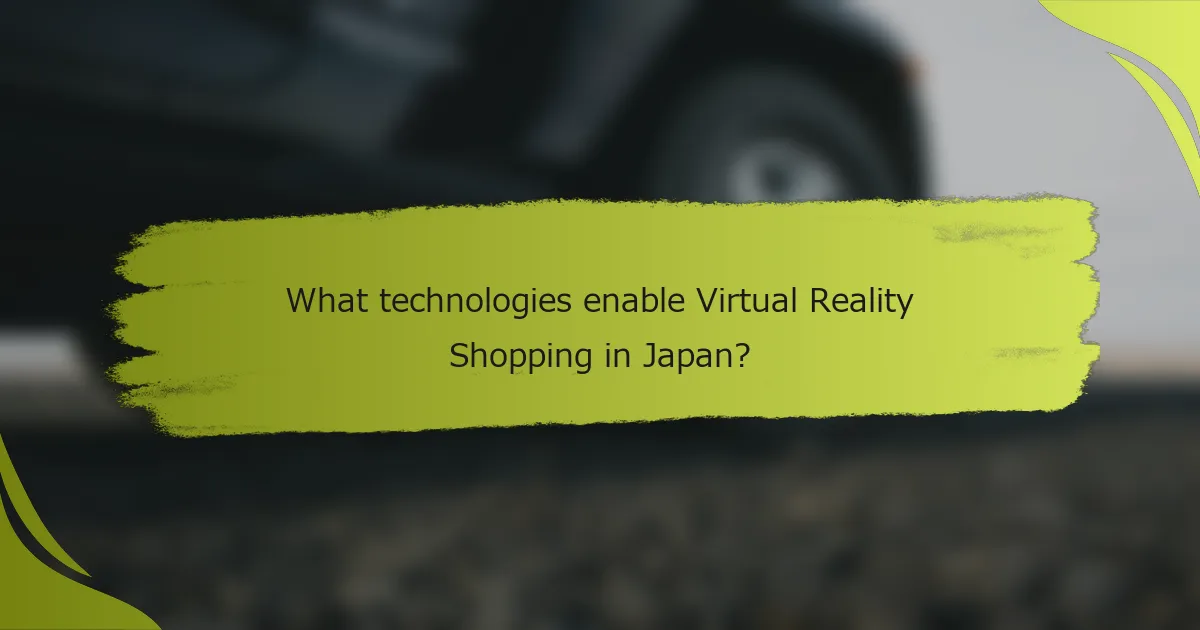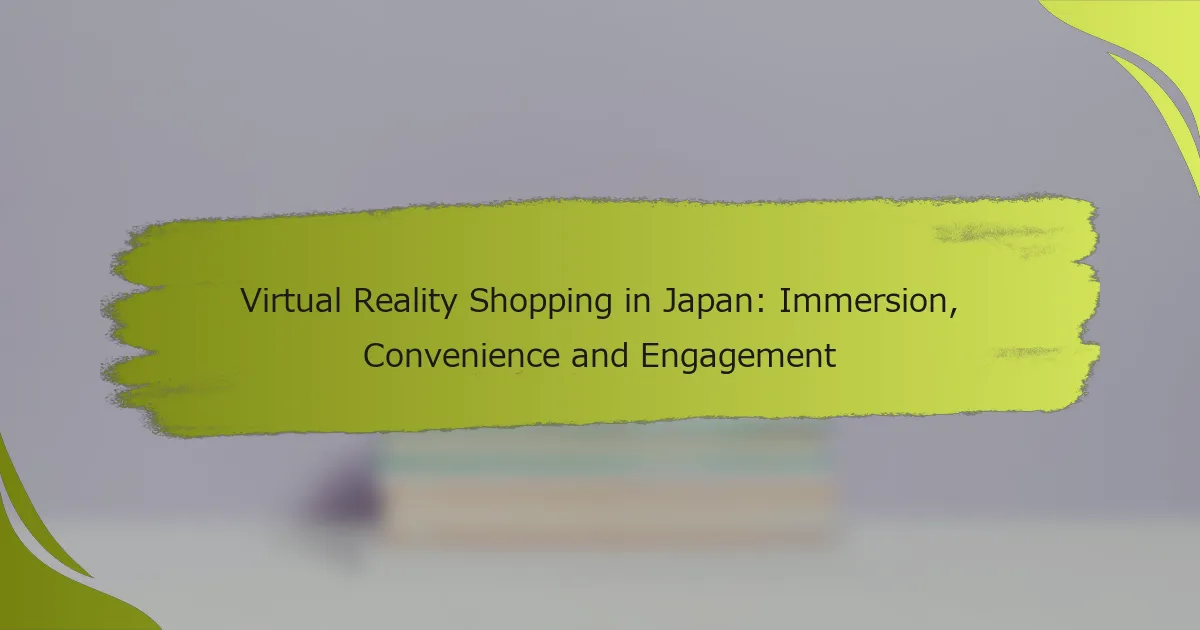バーチャルリアリティショッピングは、日本の小売業界を大きく変革しており、顧客体験を向上させ、購入プロセスを効率化しています。この技術により、消費者は仮想環境で商品と対話でき、より魅力的で便利なショッピングが実現します。

How is Virtual Reality Shopping transforming retail in Japan?
Virtual reality shopping is significantly changing the retail landscape in Japan by enhancing customer experiences and streamlining purchasing processes. This technology allows consumers to interact with products in a virtual environment, making shopping more engaging and efficient.
Enhanced customer engagement
Virtual reality shopping fosters enhanced customer engagement by providing immersive experiences that traditional shopping cannot match. Customers can explore virtual stores, interact with products, and even receive personalized recommendations based on their preferences.
Retailers can utilize gamification elements within VR environments to make shopping fun and interactive, encouraging longer visits and repeat interactions. This level of engagement helps build brand loyalty and keeps customers returning for more.
Increased sales conversion rates
Sales conversion rates are often higher in virtual reality shopping environments compared to traditional online shopping. The immersive nature of VR allows customers to visualize products in a more realistic context, which can lead to more informed purchasing decisions.
By offering a unique shopping experience, retailers can reduce cart abandonment rates and increase overall sales. Many businesses report conversion rates that are significantly above average when utilizing VR technology.
Immersive product experiences
Immersive product experiences are a hallmark of virtual reality shopping, allowing customers to examine items in detail as if they were physically present. For instance, customers can view clothing from multiple angles, see how furniture fits in their space, or even test out electronics virtually.
This level of interaction helps customers feel more confident in their purchases, as they can assess quality and functionality without leaving their homes. Retailers can showcase their products in ways that highlight unique features and benefits effectively.
Convenience of shopping from home
The convenience of shopping from home is a major advantage of virtual reality shopping. Customers can browse and purchase products at any time without the need to travel to physical stores. This flexibility is particularly appealing in urban areas where commuting can be time-consuming.
Additionally, VR shopping can integrate with delivery services, allowing for seamless transactions that bring products directly to the customer’s doorstep. This combination of convenience and technology makes virtual shopping an attractive option for many consumers in Japan.

What are the leading Virtual Reality Shopping platforms in Japan?
In Japan, the leading virtual reality shopping platforms include ZOZOTOWN, Uniqlo, and Rakuten, each offering unique immersive experiences that enhance online shopping. These platforms leverage VR technology to create engaging environments where customers can browse and purchase products as if they were in a physical store.
VR Shopping by ZOZOTOWN
ZOZOTOWN has pioneered VR shopping in Japan by creating a virtual mall where users can explore various fashion brands. Customers can navigate through a 3D environment, trying on clothes virtually and viewing items from different angles.
This platform emphasizes user engagement, allowing shoppers to interact with products and receive personalized recommendations based on their preferences. ZOZOTOWN’s VR shopping experience is designed to replicate the excitement of in-store shopping while providing the convenience of online access.
VR experience at Uniqlo
Uniqlo has integrated VR technology into its shopping experience by offering virtual showrooms that showcase seasonal collections. Customers can use VR headsets to walk through these showrooms, viewing clothing items in a realistic setting.
The Uniqlo VR experience focuses on simplicity and ease of use, allowing shoppers to quickly find and purchase items. This immersive approach not only highlights product features but also enhances customer engagement by making the shopping process more interactive.
Virtual stores by Rakuten
Rakuten has developed virtual stores that allow customers to browse a wide range of products in a 3D environment. These stores are designed to mimic the layout of traditional retail spaces, making it easy for users to navigate and discover new items.
With Rakuten’s virtual shopping, customers can enjoy features like virtual fitting rooms and interactive product displays. This platform aims to combine the benefits of online shopping with the tactile experience of physical stores, enhancing overall customer satisfaction.

What technologies enable Virtual Reality Shopping in Japan?
Virtual reality shopping in Japan is primarily enabled by advanced hardware and software technologies that create immersive experiences. Key technologies include VR headsets, augmented reality (AR) integration with smartphones, and specialized shopping platforms that enhance user engagement and convenience.
Oculus Quest 2
The Oculus Quest 2 is a popular standalone VR headset that provides an accessible entry point for virtual reality shopping. Its wireless design allows users to explore virtual stores without being tethered to a computer, enhancing the shopping experience.
With a resolution of 1832 x 1920 per eye, the Oculus Quest 2 offers clear visuals, making product details more discernible. Users can interact with virtual items using hand tracking, which simulates a more natural shopping experience.
HTC Vive Pro
The HTC Vive Pro is a high-end VR headset known for its superior graphics and audio quality, making it suitable for immersive shopping experiences. It features a resolution of 2880 x 1600, which provides sharp images that enhance product visualization.
This headset requires external sensors for tracking, which can offer a more expansive play area. However, it is generally more expensive than the Oculus Quest 2, making it a consideration for businesses aiming for premium virtual shopping environments.
AR integration with smartphones
Augmented reality integration with smartphones allows users to visualize products in their real-world environment before making a purchase. This technology is particularly useful for items like furniture or clothing, where seeing the product in context can influence buying decisions.
Many retailers in Japan are adopting AR features in their mobile apps, enabling customers to use their smartphone cameras to place virtual items in their homes. This enhances engagement and helps reduce return rates by ensuring customers are satisfied with their choices before buying.

What are the benefits of Virtual Reality Shopping for consumers in Japan?
Virtual Reality (VR) shopping offers several advantages for consumers in Japan, enhancing their shopping experience through immersion, convenience, and engagement. By utilizing VR technology, shoppers can explore virtual stores and interact with products in a more dynamic way than traditional online shopping allows.
Personalized shopping experiences
VR shopping allows for highly personalized experiences tailored to individual preferences. Consumers can receive recommendations based on their past purchases, browsing behavior, and even their virtual avatars, creating a unique shopping journey. For example, a virtual assistant can guide users through a store, suggesting items that match their style and needs.
This level of personalization can significantly enhance customer satisfaction, as shoppers feel more connected to the products and brands they are exploring. Many VR platforms also allow users to customize their shopping environments, further enhancing the personal touch.
Access to exclusive products
Consumers in Japan can access exclusive products through VR shopping that may not be available in physical stores. Many brands use VR platforms to launch limited-edition items or special collections, creating a sense of urgency and excitement. This exclusivity can drive consumer interest and engagement, encouraging shoppers to explore new offerings.
Additionally, VR shopping can connect consumers with international brands that may not have a physical presence in Japan, broadening their shopping options. This access to a wider range of products can enhance the overall shopping experience.
Time-saving features
One of the key benefits of VR shopping is its ability to save time for consumers. Shoppers can quickly navigate through virtual stores without the need to travel, wait in lines, or deal with crowds. This convenience allows for efficient browsing and purchasing, making it easier to find desired items.
Moreover, VR shopping often includes features like quick search functions and virtual try-ons, which streamline the decision-making process. Consumers can make informed choices faster, reducing the time spent on shopping trips and enhancing overall productivity.

What challenges do retailers face with Virtual Reality Shopping in Japan?
Retailers in Japan encounter several challenges with Virtual Reality (VR) shopping, including high development costs, consumer technology adoption issues, and complexities in content creation. These factors can hinder the effective implementation and scalability of VR shopping experiences.
High development costs
The initial investment required for developing VR shopping platforms can be substantial. Retailers may need to allocate significant budgets for hardware, software, and skilled personnel to create immersive experiences. This can deter smaller businesses from entering the VR market.
Additionally, ongoing maintenance and updates can add to the overall costs. Retailers must weigh the potential return on investment against these expenses to determine if VR shopping is a viable option for their business model.
Consumer technology adoption
Consumer acceptance of VR technology is still evolving in Japan. While interest in VR shopping is growing, many customers may not own the necessary devices or may be hesitant to adopt new technology. This can limit the potential customer base for VR shopping experiences.
Retailers need to consider strategies to encourage adoption, such as offering in-store VR experiences or providing incentives for customers to try VR shopping. Educating consumers about the benefits and ease of use can also help increase acceptance.
Content creation complexities
Creating engaging and high-quality VR content is a complex process that requires specialized skills and resources. Retailers must ensure that their virtual environments are visually appealing and provide a seamless shopping experience to attract and retain customers.
Moreover, keeping content fresh and relevant can be challenging. Retailers should plan for regular updates and new offerings to maintain consumer interest. Collaborating with experienced VR content creators can help streamline this process and enhance the overall quality of the shopping experience.

How do Japanese consumers perceive Virtual Reality Shopping?
Japanese consumers generally view Virtual Reality (VR) shopping positively, appreciating its immersive experience and convenience. However, there are notable concerns regarding privacy and data security that influence their overall perception.
Positive attitudes towards innovation
Many Japanese shoppers embrace VR shopping as a cutting-edge way to engage with products. The ability to virtually try on clothing or visualize furniture in their homes enhances the shopping experience and can lead to more informed purchasing decisions.
Retailers are increasingly adopting VR technology to create interactive environments that attract tech-savvy consumers. This innovation aligns with Japan’s reputation for technological advancement, making VR shopping appealing to a broad demographic.
Concerns about privacy and data security
Despite the enthusiasm for VR shopping, concerns about privacy and data security remain significant. Consumers worry about how their personal information is collected, stored, and used by retailers in virtual environments.
Many Japanese shoppers are cautious about sharing sensitive data, which can hinder their willingness to fully engage with VR platforms. Retailers must address these concerns by implementing robust security measures and clearly communicating their data handling practices to build trust.
